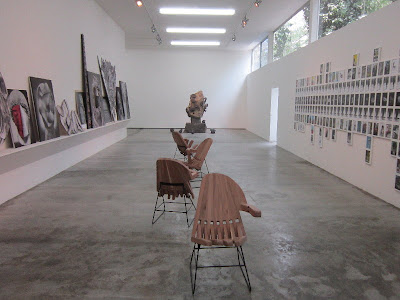























and a hammock for sale in the museum's shop
Ernesto´s Tongue.
Works 1987 – 2011
La lengua de Ernesto is the largest exhibition of Ernesto Neto´s works to date. The exhibition housed in the Antiguo Colegio de San Ildefonso features sculptures, drawings, photography and objects produced from 1987 to 2011, many of them shown here for the first time. Ernesto is a prolific artist, and his vast, complex and rich oeuvre is extremely coherent –at once formal, contemplative, relational and interactive; abstract and figurative; full of references to the body, geometry and science; pleasing to the senses and to the mind. His work is deeply ingrained in Rio de Janeiro art tradition, departing from the mid-twentieth-century Brazilian art movement neoconcretismo, where historical figures such as Lygia Clark, Lygia Pape and Hélio Oiticica contaminated the abstract geometric language of European masters like Piet Mondrian with the body and everyday life.
La lengua de Ernesto follows a chronological path, retracing many of the artist´s most significant exhibitions, which are recreated here. The show begins on the ground floor (room 5), with sculptures dating from 1987 through 1997, and continues on to the first floor (rooms 6 to 11) and the sculpture patio, displaying objects and sculptures made after 1997. More than eighty drawings shown outside the artist´s studio for the first time are brought into the narrative of the exhibition, establishing dialogues and parallels with the sculptures, while not always following the same strict chronology.
Lengua, the Spanish word for tongue, has at least two definitions: on the one hand, it is language itself, a method of communication, a codified and structured set of elements developed by the artist. On the other hand, it is the fleshy muscular organ inside your mouth used for tasting, licking, swallowing and articulating the sounds of speech. As part of the title of the exhibition, lengua displays this richness of connotation, bringing together language and the body, an intellectual construction and a corporeal element, all close to Ernesto Neto´s themes and concepts.
Adriano Pedrosa, Curator.
La lengua de Ernesto is the largest exhibition of Ernesto Neto´s works to date. The exhibition housed in the Antiguo Colegio de San Ildefonso features sculptures, drawings, photography and objects produced from 1987 to 2011, many of them shown here for the first time. Ernesto is a prolific artist, and his vast, complex and rich oeuvre is extremely coherent –at once formal, contemplative, relational and interactive; abstract and figurative; full of references to the body, geometry and science; pleasing to the senses and to the mind. His work is deeply ingrained in Rio de Janeiro art tradition, departing from the mid-twentieth-century Brazilian art movement neoconcretismo, where historical figures such as Lygia Clark, Lygia Pape and Hélio Oiticica contaminated the abstract geometric language of European masters like Piet Mondrian with the body and everyday life.
La lengua de Ernesto follows a chronological path, retracing many of the artist´s most significant exhibitions, which are recreated here. The show begins on the ground floor (room 5), with sculptures dating from 1987 through 1997, and continues on to the first floor (rooms 6 to 11) and the sculpture patio, displaying objects and sculptures made after 1997. More than eighty drawings shown outside the artist´s studio for the first time are brought into the narrative of the exhibition, establishing dialogues and parallels with the sculptures, while not always following the same strict chronology.
Lengua, the Spanish word for tongue, has at least two definitions: on the one hand, it is language itself, a method of communication, a codified and structured set of elements developed by the artist. On the other hand, it is the fleshy muscular organ inside your mouth used for tasting, licking, swallowing and articulating the sounds of speech. As part of the title of the exhibition, lengua displays this richness of connotation, bringing together language and the body, an intellectual construction and a corporeal element, all close to Ernesto Neto´s themes and concepts.
Adriano Pedrosa, Curator.













































